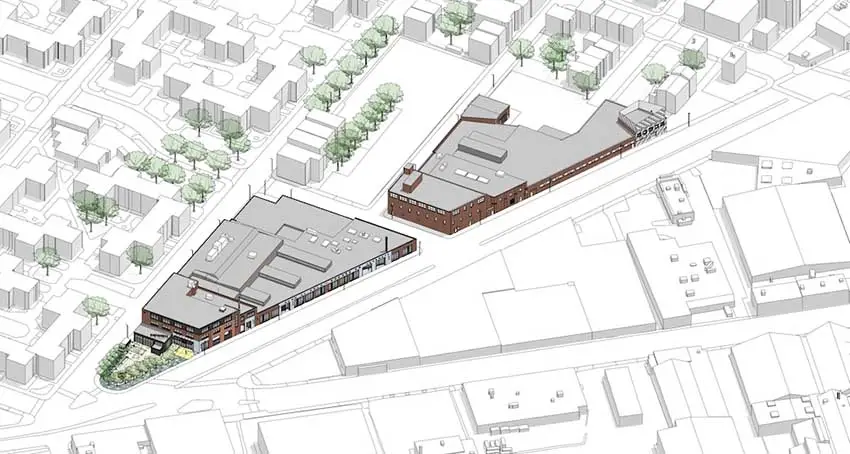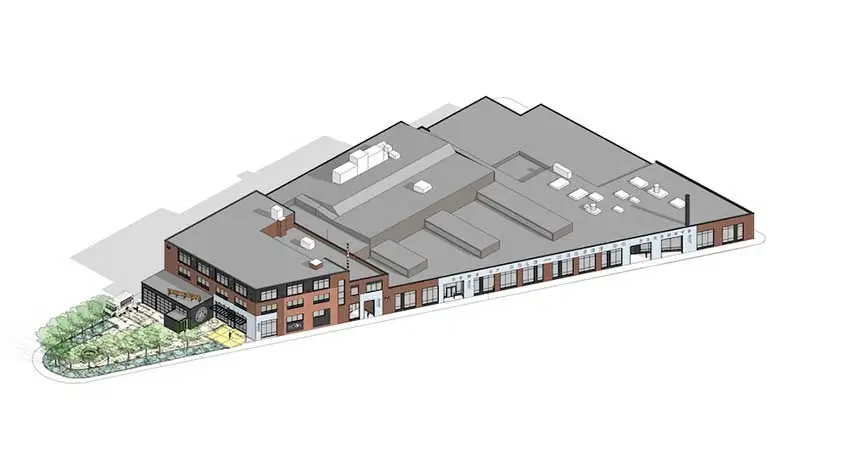Iron Works by Hacin + Associates
Boston, MA | Commercial - Retrofitting | Cranshaw Construction
- Interview Featuring:
- Matthew Arnold
- and
- Srishti Goyal

At the Iron Works development in South Boston, an old switch factory is reimagined as a mixed-use development to help revitalize the neighborhood.
The Cole Hersee buildings mark the first phase of the Iron Works development in South Boston, which acts as a “stitch” between old and new urban fabric in the neighborhood. Hacin + Associates, working with National Development, reimagined the two former electrical switch manufacturing facilities, originally built in 1910, to provide 135,000 square feet of modern office, retail, and restaurant space — including 75,000 square feet of ground-level accessible space. In addition to unifying the windows across the project and providing color-blocked facade treatments, the phased design includes planned storefront systems and glazed garage doors, the more expansive fenestration will better serve the buildings’ new tenants while more directly engaging the street.
Acelab spoke with Matthew Arnold and Srishti Goyal of Hacin + Associates about how window and door products helped breathe life back into these buildings.

An updated feature of the original Cole Hersee buildings feature the graphic murals designed by Hacin + Associates design team and painted by Boston decorative muralist Mark Grundig. (© Image by Gunnar Gleuck | Flaunt)
Acelab: Sounds like a really engaging site and design brief. How will you activate the streets to connect the two parts of the city?
Matthew: The buildings had a lot of old industrial transom windows and light monitors that were 15 feet off the ground but most of them didn’t promote the kind of interior-exterior relationship we need. The building has 15-foot high ceilings which make really great open large spaces. We wanted to connect that open feeling to the street, both literally with garage doors as well as visually with fixed window walls.

Before image.

After image featuring the murals of Mark Grundig. (© Image by Gunnar Gleuck | Flaunt)
Acelab: What are the challenges and opportunities in repurposing older buildings like this?
Matthew: They are reinforced masonry buildings so they are not up to seismic requirements. So essentially anytime we removed brick, we needed to add lateral stability back to the building by putting a frame of steel around the inside of the window to reinforce the opening.
Those steel frames were complex, costly, and difficult. We worked with manufacturers and consultants to develop better ways to insert these windows and found that some renovations had been done where original openings were blocked back up, so we located them and reopened them. It saved us time and money because the original, blocked-off windows already had a concrete header. This worked even if we were expanding the window vertically all the way down to the ground.

Before shot of the Cole Hersee buildings.

After view from the streets (© Image by Gunnar Gleuck | Flaunt)
CAD Drawing
Acelab: The window details are the same for all the buildings?
Srishti: Consistency in the windows was the main design consideration because there was so much inconsistency in these buildings. They are all different heights and the floors don't align, so we had these 200-foot facades where nothing lined up.
Some of the windows were squares, some were rectangles, some of them were single or double doors. We really tried to replicate the same details over and over again. We also tried to line mullions up even if the windows themselves weren't aligning to draw a datum. Painted color blocking on the facade makes visual and aesthetic sense out of it all.

Before

After (© Image by Gunnar Gleuck | Flaunt)
Acelab: Were there special concerns about daylighting?
Matthew: The spaces are very cool, because they are old industrial spaces with decades of patina. We wanted to make sure they were very well-lit, of course, to highlight that. On the ground floor, we used 15-foot-tall ArmRLite garage doors that allow great views into the spaces and create a physical connection to the retail and restaurant spaces that are really animated when all of those big doors are open and people are hanging out.


Acelab: Adaptive reuse is always a good choice from a sustainability point-of-view, but what were the performance challenges it posed?
Matthew: The old masonry buildings are uninsulated and there are no air and vapor barriers or air cavities with weep holes. Inserting multi or double pane fully insulated glazing units into a wall that has zero insulation is tricky. We wanted to connect those two systems together in a logical sense while still being forward-thinking about sustainability and energy consumption when working within an existing uninsulated masonry building.
Acelab: What were some of the considerations in bringing the old masonry structure and these new windows together?
Srishti: The jamb detail is where the two systems meet. Since the cut of the masonry is not going to be perfect, we wanted to wrap the opening so that if any moisture did get in there, the jamb is protected. We do have weeps and flashing to let any moisture drip out.
Acelab: So what product choices helped mitigate some of these problems?
Srishti: We're using primarily Kawneer as our manufacturer. We're using their 1600UT curtain wall system for the larger openings which are 12-to-15-feet wide and high. For our smaller windows, we're using the 451T storefront system with the 352 medium style doors, which have been really great for our smaller openings.
Many thanks to Matthew and Srishti from Hacin + Associates for taking the time to talk with us. You can read more about The Cole Hersee buildings on their website.
This interview was conducted by ADvsCOPY for Acelab. It has been condensed and lightly edited.

